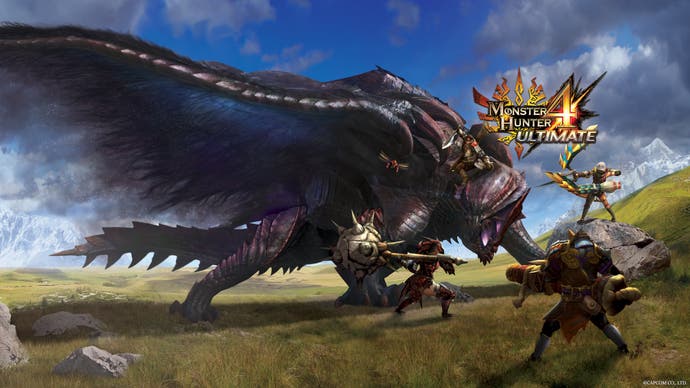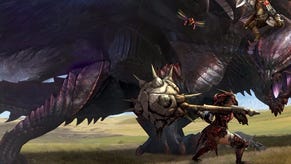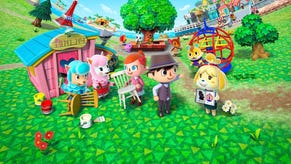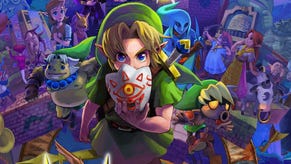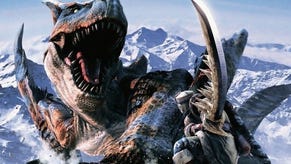Games of 2015 no. 8: Monster Hunter 4 Ultimate
The thrill of the hunt.
Monster Hunter 4 Ultimate makes me feel like a kid again - and sometimes, being a kid can be a real pain. Every school day you're overloaded with a flurry of information that you find yourself only half paying attention to, monetary income is sparse, and time always moves just a little too slow as you await the next exciting life change. But then you get to fight dinosaurs in a video game.
I'm not sure what it is about dinosaurs that makes them the best of all monsters to tackle. Comparatively, Nazis are boring, robots too conceptual, and magic-casting demons too far-fetched. Even though little is known about our planet's prior residents, they feel real to us. We occupy a world full of grizzly bears, crocodiles, hippos and lions, so encountering toothy, leathery variations of these beasts isn't that hard to imagine. They're fun to fight not because they're evil, but because trying to eat one another seems natural. They have teeth and tails and venom, while we have swords and hammers and bows. It's a fair fight that's fraught with desperation, but lacking in malice.

That's how Capcom can make a game about slaughtering wildlife and have it feel shockingly non-violent. Set in an array of plucky, colourful tribal villages, Capcom's Monster Hunter is perhaps the most jovial game series ever made about survival. There is a plot, but it's of a threadbare sort and focuses on defeating some particularly nasty threats impeding various townsfolk. By and large, you're not hunting to stop an ancient evil, or for sport. You're just going out there to hunt because you and your brethren need food and clothing made from the neighbouring predators - creatures that are portrayed with a surprising reverence.
This gives the "hunting" of the title an air of innocence which puts anyone who engages with it in a childlike mood - but it's not just the whimsical carnivores that revert you to your primary school days. Monster Hunter 4 Ultimate is such an optimistic and cute game. It's impossible not to be charmed by its talking, pun-loving catfolk, its silly animations, and its upbeat, fourth-wall-breaking slackerspeak. You can bring your Palico pals - who exist somewhere between pet and sidekick - into battle with you and dress them up in all manner of ridiculous costumes, nodding to your favourite Nintendo or Capcom characters. When you run within earshot of a raging beast, your character goes into full-on Bugs Bunny mode, with their chest puffed out and proverbial tail tucked between their legs. Even the eating animation is delightful.
However, it's not all fun and games in a game that's often, but not always, fun. Monster Hunter requires a lot of studying before you can get anything out of it. The series is notorious for its lengthy tutorials and overwhelming array of stats, skills, items, mini-games and customisations. Monster Hunter 4 Ultimate has by far the series' best tutorial, but is still front-loaded with hundreds of text screens about complex systems; information that is hard to retain when all you want to do is hunt some monsters. To get the most out of Monster Hunter, you need to do a fair bit of online research and watch some YouTube guides to its esoteric intricacies.
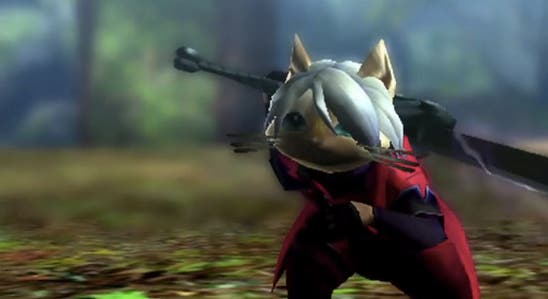
It's a rather imposing undertaking, to be honest; it's basically learning a new profession. You can't expect to become a mechanic or learn to play an instrument in a day, and the same goes for Monster Hunter, which, it occurs to me, is a job sim of sorts.
This might sound boring, but if you stick with it and breach the steep learning curve, it unfurls to reveal a deep and rewarding, if rather harrowing, trade. Each monster features a complex set of moves and behaviours. Like all video game bosses, they have tells that telegraph certain attacks, but their move counts are difficult to keep track of and your actions take much, much longer to perform than you initially think. Some of the heavier weapons can take a good couple of seconds between the time you press the attack button and the time the strike actually lands (or at least, it feels that long). It's incredibly awkward at first, but once you've spent enough time in this role, it becomes clear that this slow pace is not sloppy combat design, but an intentional decision that tests your observational skills more than your quick reflexes. Play it like Bayonetta or Bloodborne and you'll surely fail, but the game slowly teaches you to think like a hunter.
This trade-like focus means that there's lot of repetition in Monster Hunter 4, so I'd advise playing it in short bursts or breaking it up between solo hunts and co-op ones. But even the repetitive mission structure can contain some nasty surprises, as you frequently encounter a second, high-caliber predator in the same area as your target. Sometimes they'll even fight each other, offering a feeling that anything can happen; it may sound like a rote profession, but it's far from it.
Monster Hunter 4 Ultimate is more of a hobby in its own right than just another video game. It doesn't have the breezy pacing of Nuclear Throne, the grand majesty of Bloodborne or the engaging characters of Everybody's Gone to the Rapture, but hobbies aren't expected to contain that sort of breadth. Instead, Monster Hunter 4 is about one thing and one thing only: hunting monsters. It just so happens that doing so is a much more complex job than you may have thought. It's not for everyone, but if you've got the resolve to learn the ropes, it's a grand life.
